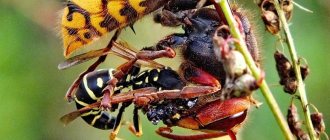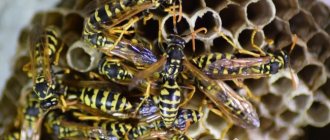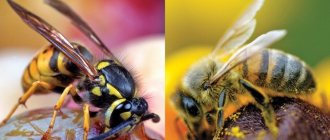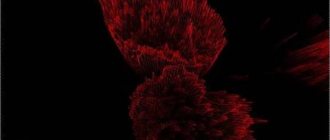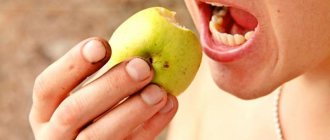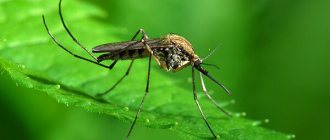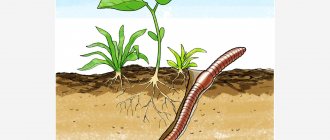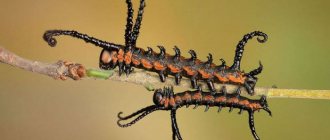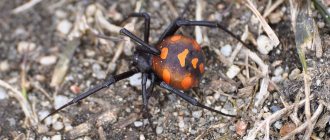Reproduction, nutrition, habitats and lifestyle features of the hornet species vespa mandarinia, Japanese hornet - what danger can it pose to humans? First aid for a bite. The occurrence of an allergic reaction - danger and risks.
The Japanese hornet is a large stinging insect that shares similarities with wasps. The bites of the presented insect are not only quite painful, but also very dangerous for humans. Note that due to attacks by Japanese hornets, about 40 people die in Japan every year.
What it looks like, dimensions
The giant hornet is distinguished by the presence of a yellow head, on which the main pair of eyes and 3 additional ones are located. Brown and yellow stripes can be seen on the body. The body is characterized by a length of about 4 centimeters, the span of the porch reaches 6 centimeters. The sting has a straight shape and is 6.25 millimeters; after a bite, it does not remain in the human skin. The sting venom contains a number of toxins and histamines that can cause a severe allergic reaction in humans.
Such insects are found in gardens, allotments, and in the wild. It is often found in apiaries, where wasps need to be protected from it, since a family of hornets will destroy everyone. You can see what the Far Eastern vespa mandarinia looks like in the photo.
Japanese hornet
Giant insects are not only a figment of the sick imagination of science fiction writers, but also a reality of life on earth. This is confirmed by the huge Far Eastern hornets, their other name is Vespa Mandarinia Japonica - Japanese hornets, and the Japanese themselves called them “suzumebachi”, which means “sparrow-bee”. This is a huge arthropod insect, dangerous with its poison even for humans. Also on this list are the Japanese giant wasp and the Japanese killer bee. Every insect that is potentially dangerous to humans does not actually hunt people, but rather protects its habitat. A person is stung by these insects due to his own negligence. True, for the “bitten” this is little consolation. To avoid defeat, you need to know a little more about their habitat and their habits.
Insect reproduction
When spring arrives, the fertilized female begins the process of building a nest using the bark of branches. Since she has a powerful jaw, it is not difficult for her to crush it. Wood particles are moistened with saliva. Next, from the laid eggs (about 300), larvae appear (after a week), which after a month turn into young individuals capable of independent feeding and caring for the larvae.
The young female begins mating and looks for a new nesting site. With the onset of the cold season, male representatives die (males have a short life span). Queens that cannot lay eggs are expelled from the colony, which is why it dies in a fairly short time.
Features of the life of the Japanese hornet
They live and hunt in packs. Like bees, hornets have their own hierarchy:
- The queen is the head of the pack, she creates a colony, and all other individuals serve the same goal - to raise young animals.
- The Japanese huge hornet is a predatory insect that feeds on nectar only for dessert, and their daily menu should include bees, bumblebees and other insects that are inferior to it in size and succumb to their powerful jaws.
- Hornets live in nests that they make themselves from chewed tree bark. Usually these are gray hollow vessels with a hole that look like a sea shell. As soon as the nest is ready, the queen lays larvae, and then the whole flock is engaged in feeding and nurturing the larvae. It is during this period that hornets are especially aggressive.
- Hornets hunt strategically. First, scouts fly out and look for hives with bees. Soldier bees always try to neutralize scouts. If the hornets are discovered in time, then each of them is surrounded by a ball of bees; they swarm around it, creating a temperature inside the swarm of over 40°C, which kills the enemy. But, if the scouts are not destroyed, they will bring a flock of killers who will destroy all the inhabitants of the hive, even the bee larvae.
- In spring, the queen leaves her nest and looks for a place to create a new family. She makes the first clutch of eggs of the season, feeds and cares for them herself. When the young grow up, they begin to build a nest and care for subsequent clutches of larvae. This continues the cycle of creating new hornet colonies.
- Hornet families live only one year. When the young grow up, the young hornets mate. After mating, the males die, and the fertilized queens, having survived the winter or rainy season, lay larvae, and the cycle repeats.
- When hunting, they actively use their powerful jaws - mandibles, with which they crush their victims. The larvae feed only on the “meat” of other insects, while adults are omnivores and do not disdain meat and fish, as well as sweet fruits.
Danger
The bites of Japanese hornets are very painful - it can be compared to a blow from a hot nail. When bitten, an insect releases a toxic poison, which poses a danger to people prone to allergic reactions. Multiple bites have a risk of death. Young children need to be especially careful.
In addition to allergic reactions, the poison can lead to cardiac arrest and anaphylactic shock. Such signs appear immediately after the attack.
The venom produced by the imperial fatty hornet includes mandorotoxin and acetylcholine. The last component is also used to attract their relatives. Most often, those who have previously killed the insect or are too close to the habitat of the family are susceptible to attack. It is almost impossible to escape or hide from such dangerous individuals - they will pursue offenders at a distance of up to 5 kilometers.
Why is the hornet of the genus Vespa mandarinia dangerous for humans?
Important! Japanese hornets use their stings for protection.
In any case, this is what famous entomologists, scientists who study insects, say. They advise that if you see a hornet nest, you should urgently leave this area, because the insect will regard their appearance as a desire to harm the larvae, and then the person will be attacked. The local population and visitors who have become victims of the stings of these giant insects do not agree with entomologists. Hornets strike with their toxic poison even far from their nest due to their bad character. A meeting between a person and a Japanese hornet does not bode well, so you should not expect that the hornet, sitting on your body, will simply flutter up and fly away. It will sting, and this is not only very painful, but also life-threatening, because the poison that it injects has the following composition and properties:
- Mandrotoxin is a neuroparalytic toxin that causes unbearable pain that torments the stung person for a long time, so that no pain relief helps.
- Histamines and the protein contained in the venom of this giant cause a violent allergic reaction that can only be blocked by injections of adrenaline. But, if a person is prone to allergies, then anaphylactic shock from the sting of this insect occurs almost instantly, so the outcome can be fatal. Most people who die from the Japanese hornet are allergy sufferers who did not get help quickly enough.
- Tissues affected by poison disintegrate very quickly under the influence of the protein contained in the poison. This process is difficult to stop, and people recover from a hornet for a very long time, because tissue necrosis, extensive hemorrhages, and often damage to internal organs occur.
Providing first aid to the victim
If you are bitten by a Japanese giant hornet, first aid must be provided to the victim immediately. First, you need to try to suck out at least a minimal amount of poison to reduce the intensity of the spread of this substance. Next, to disinfect the area, you need to use hydrogen peroxide, manganese solution or alcohol.
After this, apply wet sugar to the affected area on the skin, and a compress of ice or ice liquid on top. This maneuver will make it possible to draw back some of the poison. If you don’t have such ingredients on hand, take a slice of apple, garlic, onion, and plantain leaf.
Since the hornet does not leave a sting in the skin like bees, there is no need to look for it and try to remove it.
What not to do
When providing first aid to someone who has been stung, you must also know what you should never do:
- Drink alcohol. Alcohol will further increase the swelling of soft, damaged skin tissue.
- It is forbidden to take Diprazine. It triggers the body's own immune response to a hornet sting.
- You cannot ignore a hornet bite, much less hope that nothing happens.
If a giant bites someone close to you, first aid must be provided.
If you behave tactlessly towards these insects, you should be prepared for unpleasant consequences. It is worth remembering that a hornet will never attack a person unless a threat comes from him. And some people get along with these people for years. In response, they protect the crop from various garden pests. But just in case, you should always have first aid supplies on hand.
Allergy
For the victim, it is necessary to take antihistamine or glucocorticoid drugs.
Among these means:
- Suprastin;
- Diphenhydramine;
- Loratadine;
- Dexamethasone;
- Hydrocortisone;
- Prednisolone.
With timely use of the above-mentioned medications, you can eliminate the risk of developing severe symptoms and an allergic reaction.
Note that the drug is characterized by the presence of side effects, so it should be taken only if necessary in order to prevent a worsening of the person’s condition.
If there is no allergic reaction, the pain syndrome can be relieved with the help of special ointments and balms, among which Soventol and Fenistil gel are very effective.
Lifestyle and nutrition
Each individual has its own responsibilities. Thus, the uterus is entrusted with the function of procreation; hard-working hornets are engaged in delivering food for it and the larvae. They feed on honey bees, agricultural pests, sugar-containing vegetables, and fruits. If a Japanese hornet discovers a hive of bees, it marks it with an odorous liquid so that it can later return here with its brothers. During the attack, they literally dismember their prey. Having dealt with large bees, the giants take honey and larvae for further food.
Interesting: in 90 minutes, 30 hornets can destroy an entire bee family. The giant will need no more than 60 seconds to destroy up to 40 bees.
The largest bumblebee in the world
Bumblebees are part of the bee genus and are one of the closest species to ordinary honey bees. The largest are the Asian ones, which are often called killer bumblebees or tiger bees due to their tiger-like coloring.
These insects are usually quite large in size:
- the body is about 30 mm long in females and 26 mm in males;
- the width is about 15 mm;
- The wingspan can reach 50 mm in the largest individuals.
Note! Giant killer bumblebees most often live in forests, groves and agricultural lands, since in this area it is more convenient for them to build nests, which are usually located in the crowns of trees. Bumblebees are dangerous and their poison is quite strong
After being stung, a person can easily end up in the hospital.
Giant bumblebee, or tiger bumblebee, is a name most often found in Japan or China. Despite the development of medicine and the creation of new drugs, a relatively large number of people still die from attacks by representatives of this species, numbering in the hundreds all over the world. The bumblebee is a more aggressive insect, and there are cases when it attacked first. It has well-developed jaws, so it can not only sting, but also bite painfully. Bites, by the way, hurt the most. However, for residents of Russia and other CIS countries there is no reason to fear, since this class does not occur here. You should only be careful if you are planning a trip to Asian countries.
Giant killer bumblebees most often live in forests, groves and farmland
Important! The giant bumblebee has a relatively small wingspan, making it appear that this insect is unable to fly normally. This disadvantage is compensated by more frequent strokes, sometimes the frequency can reach more than 400 per second, which is almost impossible to notice with the naked eye
This class of insects feeds on the sap of trees and plants, as well as the nectar of flowers. The sting remains with the bumblebee after the attack, and therefore it has the ability to use it repeatedly. During the attack, he injects a small amount of poison. Particularly dangerous can be cases where it gets into a vein or vessel. Then the poison acts on the body faster. This manifests itself as more severe pain and swelling. An affected person with an allergy needs immediate medical attention.
Giant bumblebees and hornets are insects of enormous size for their species. They are poisonous and can cause severe harm. Despite this, they rarely attack on their own, most often in order to protect their habitat. This is worth considering when planning a trip to Asian countries. In Russia they are rare, but still, whoever is warned is protected!
Habitat
The homeland of this insect is Japan. Beyond its borders, the Japanese hornet lives exclusively in the southern part of Sakhalin Island. In Eurasia, its closest brother is the Asian hornet. On the territory of the Russian Federation, its habitat is the Primorsky Territory. This is where it is found most often.
The hornet's cocoon is very similar to a wasp's nest; it is distinguished from the latter by its exceptionally large size. If a person himself does not bother them, they will not attack him. They attack if they are in great danger. To get rid of nests, you should use the services of certified specialists. Otherwise, there is a high probability of being stung.
